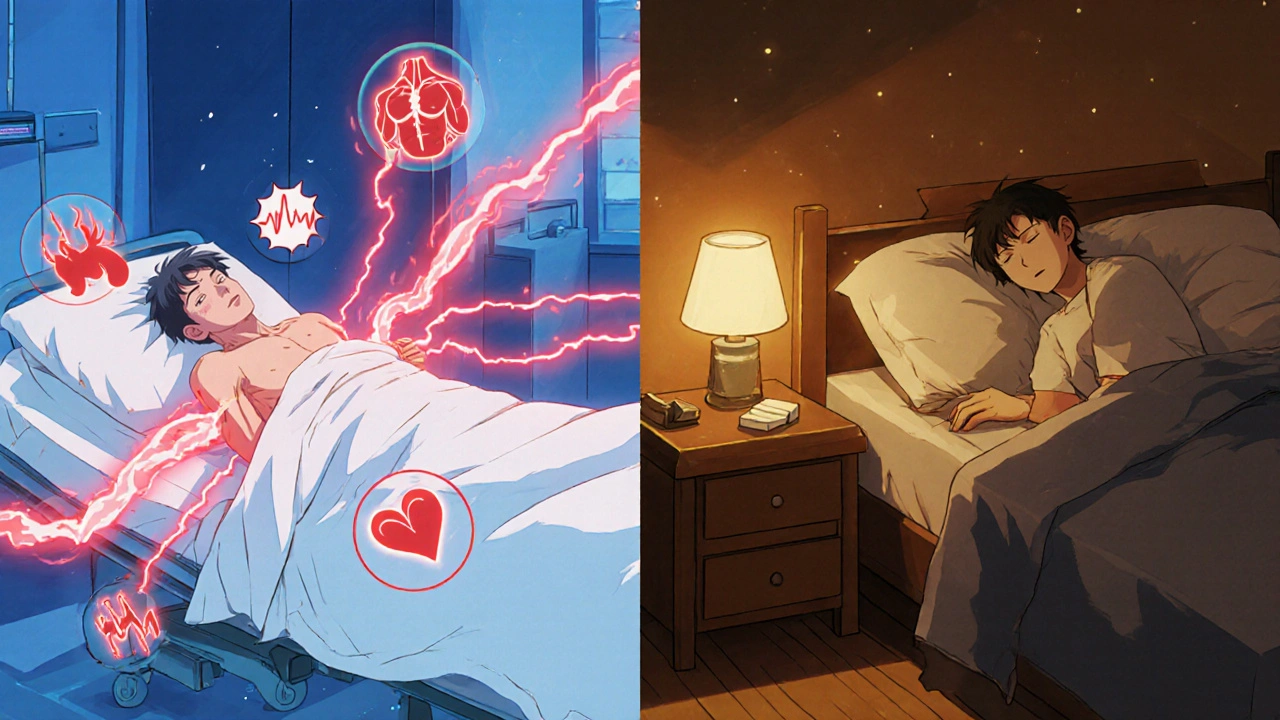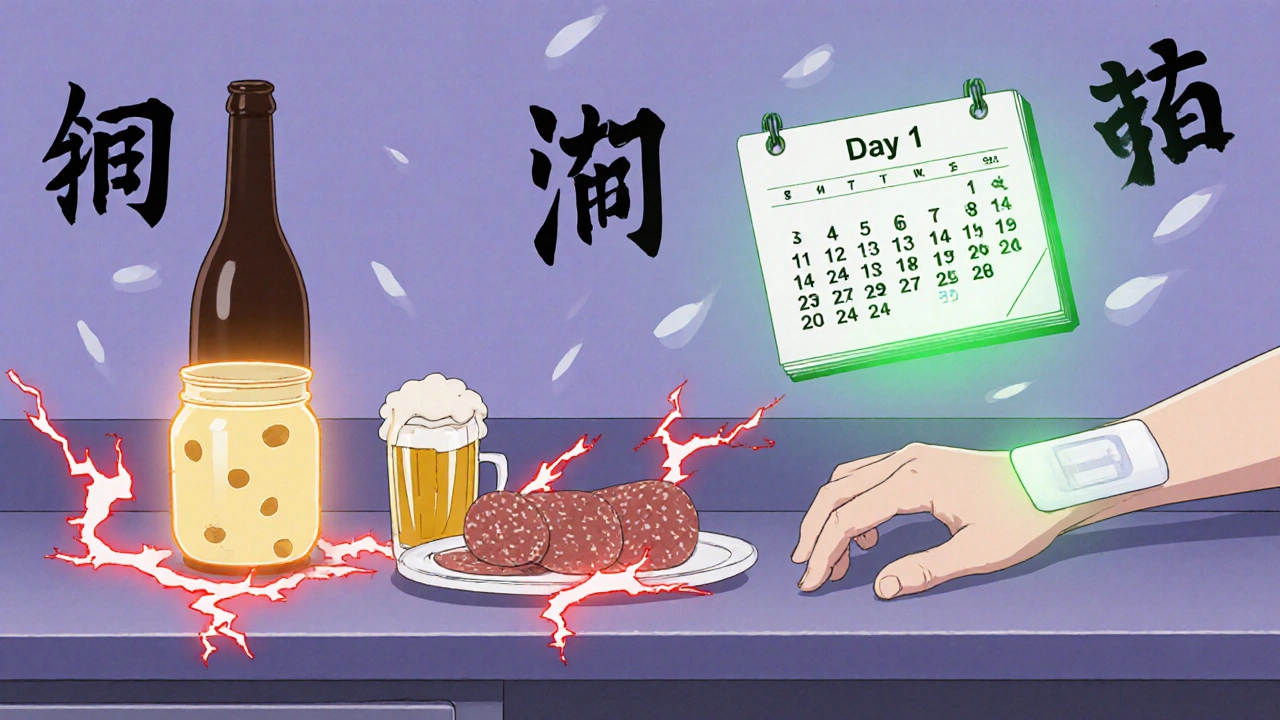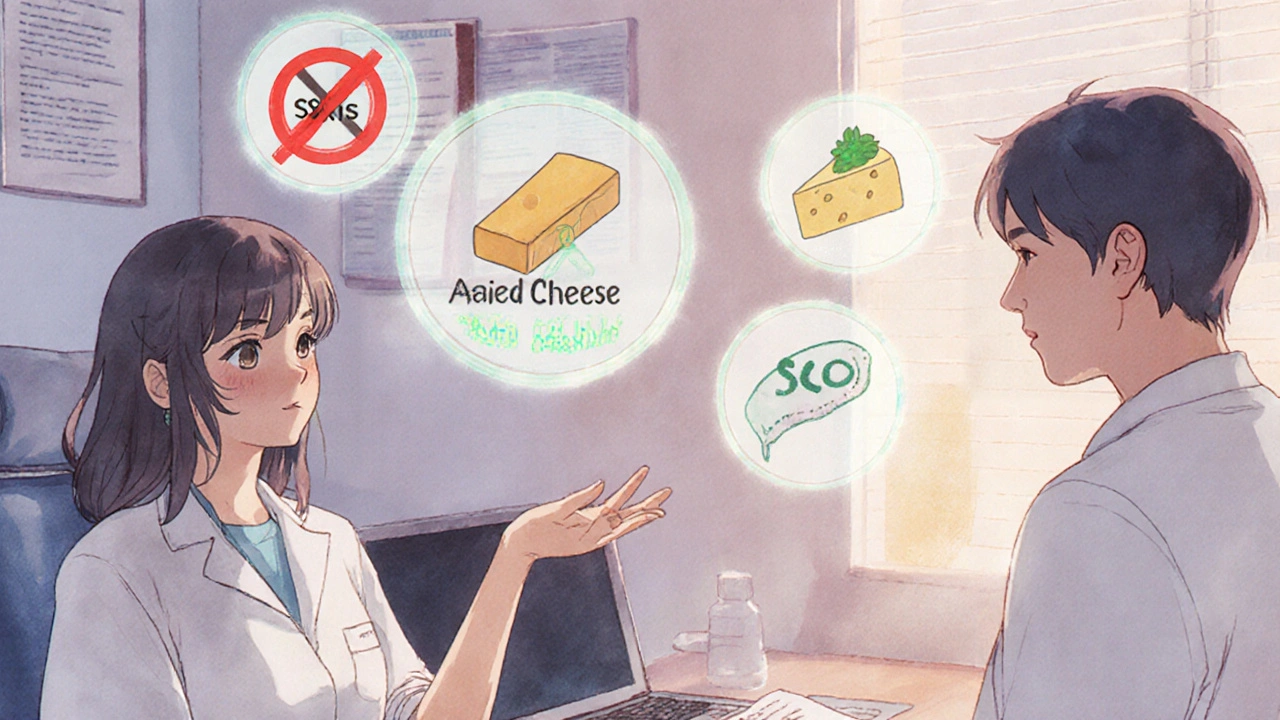MAOI Medication Interaction Checker
Select Your MAOI
Select Other Medication
Combining MAOIs with other antidepressants can be life-threatening-if you don’t know what you’re doing. Monoamine oxidase inhibitors (MAOIs) like phenelzine, tranylcypromine, and the selegiline patch aren’t first-line treatments anymore. But for people with treatment-resistant depression, they’re often the only thing that works. The problem? One wrong move with another medication, and you could trigger serotonin syndrome-a medical emergency that can kill you in hours.
Why MAOIs Are Still Used (Despite the Risks)
MAOIs were the first antidepressants ever developed, back in the 1950s. They work by blocking the enzyme that breaks down serotonin, norepinephrine, and dopamine. That means more of these mood-lifting chemicals stay active in your brain. For most people, SSRIs and SNRIs are enough. But for about 20-30% of those with depression, nothing else helps. That’s where MAOIs come in.They’re especially effective for atypical depression-where you feel heavy, exhausted, sleep too much, and are hypersensitive to rejection. Studies show 40-60% of treatment-resistant patients respond to MAOIs, even after failing multiple other drugs. The transdermal selegiline patch (Emsam) has made them easier to use: at the lowest dose (6 mg/24 hr), you don’t need to avoid aged cheese or tap beer. That’s why more psychiatrists are turning to it now.
The Deadly Combo: MAOIs + SSRIs/SNRIs
This is the most dangerous interaction you can make. Mixing MAOIs with SSRIs (like fluoxetine, sertraline) or SNRIs (like venlafaxine, duloxetine) can cause serotonin syndrome. It’s not a myth. It’s not rare. It’s deadly.A 1995 study in the Journal of Clinical Psychiatry looked at eight cases where people took fluoxetine and tranylcypromine together. Seven of them died. The FDA issued a boxed warning-its strongest alert-because of this. You can’t just switch from one to the other. You have to wait.
- If you’re coming off fluoxetine, wait 5 weeks before starting an MAOI. Fluoxetine and its active metabolite stick around for weeks.
- If you’re coming off other SSRIs or SNRIs, wait 14 days.
- If you’re coming off an MAOI, wait 14 days before starting any SSRI or SNRI.
Why so long? Your body needs time to rebuild the monoamine oxidase enzyme that the MAOI shut down. If you start an SSRI too soon, serotonin floods your system. Your muscles lock up. Your temperature spikes. You might sweat uncontrollably, have seizures, or go into shock. Emergency rooms see this every year. And it’s almost always preventable.
What About Tricyclic Antidepressants (TCAs)?
This is where things get messy. For decades, doctors were told: never combine MAOIs with TCAs like amitriptyline or clomipramine. The theory was simple-both raise serotonin. Too much = serotonin syndrome.But recent research says: maybe not. A 2022 review in PMC9680847 found that some patients have safely taken MAOIs with certain TCAs-especially nortriptyline. The key? Timing and choice.
- Never combine MAOIs with clomipramine. It’s too strong on serotonin.
- Nortriptyline is the safest TCA to pair with an MAOI-if done right.
- You must start the TCA first, or at the same time. Never add the MAOI after the TCA is already running.
Dr. J. David Amsterdam’s 2009 study showed 57% of treatment-resistant patients improved when phenelzine was combined with nortriptyline. No serious side effects. But this isn’t something you try at home. Only experienced psychiatrists should attempt this, with close monitoring.

Safer Alternatives: What You Can Combine With MAOIs
You don’t have to give up on combination therapy. There are antidepressants that won’t trigger serotonin syndrome when paired with MAOIs.- Bupropion (Wellbutrin): Works on dopamine and norepinephrine, not serotonin. No interaction risk. Often used to boost energy and motivation in MAOI-treated patients.
- Mirtazapine (Remeron): Blocks certain serotonin receptors instead of boosting levels. Safe in combination. Used in multiple case reports for treatment-resistant depression.
- Trazodone: Low doses help sleep without raising serotonin dangerously. Often added for insomnia on MAOIs.
- Nortriptyline: As mentioned, it’s the TCA of choice-if used correctly.
Some clinicians even add dopamine agonists like pramipexole for patients stuck in anhedonia-where nothing brings joy. Case reports show it works well with MAOIs, but you need to go slow. Start with 0.125 mg and increase every week. Watch for nausea, dizziness, or impulse control issues like gambling or hypersexuality.
What About Sleep and Anxiety Meds?
You don’t have to suffer through insomnia or panic attacks while on an MAOI. Benzodiazepines like lorazepam or clonazepam are safe. So are non-benzodiazepine sleep aids like zolpidem or trazodone (again, low dose). These don’t interfere with monoamine oxidase. They’re often essential for helping patients stabilize.Just avoid dextromethorphan (found in many cough syrups), tramadol, and certain migraine meds like triptans. These can also trigger serotonin syndrome. Always check with your pharmacist before taking anything new-even over-the-counter stuff.
Dietary Risks Are Still Real
MAOIs block the enzyme that breaks down tyramine-a compound in aged, fermented, or spoiled foods. If tyramine builds up, it causes a sudden, dangerous spike in blood pressure. This isn’t just a warning on the bottle. It’s a real risk.Avoid:
- Aged cheeses (cheddar, parmesan, blue cheese-over 20 mg tyramine per 100g)
- Tap beer and draft wine (over 10 mg per 100ml)
- Fermented sausages like salami or pepperoni (over 100 mg per 100g)
- Soy sauce, miso, and fermented tofu
- Overripe bananas, avocados, and fava beans
Even the selegiline patch isn’t risk-free. At higher doses (9 mg/24 hr or above), you still need to watch your diet. And you must keep avoiding these foods for two weeks after stopping the MAOI. Your enzyme levels haven’t fully recovered yet.

Stopping MAOIs Isn’t Easy
People think if you stop an SSRI, you might feel a little off for a few days. With MAOIs, it’s different. Abruptly stopping can cause:- Restlessness (62% of cases)
- Upset stomach (48%)
- Tingling or burning skin (37%)
- Flu-like symptoms (55%)
- Severe insomnia (71%)
- Intense headaches (68%)
That’s not withdrawal. That’s your nervous system screaming because it’s been deprived of enzyme activity for too long. Always taper slowly-over 2 to 4 weeks. Never stop cold turkey.
Who Should Be Prescribing MAOIs?
Only about 5-10% of depression specialists regularly prescribe them. Why? Because most doctors aren’t trained to use them safely. A 2019 study found only 32% of psychiatry residents felt confident managing MAOI interactions.That’s dangerous. These drugs aren’t for general practitioners. They’re for specialists who know the washout periods, the safe combinations, the red flags. If your doctor isn’t comfortable explaining why you can’t take a cold medicine or a new antidepressant, find someone who is.
The Bottom Line
MAOIs aren’t outdated. They’re powerful. But they’re like a high-performance engine-you need the right fuel, the right timing, and someone who knows how to drive it. For people with treatment-resistant depression, they can be life-changing. But one mistake can be fatal.If you’re on an MAOI:
- Never start or stop another antidepressant without your psychiatrist’s approval.
- Stick to the 14-day (or 5-week for fluoxetine) washout rule.
- Only combine with bupropion, mirtazapine, trazodone, or nortriptyline-never SSRIs or clomipramine.
- Avoid tyramine-rich foods.
- Taper slowly when stopping.
For patients who’ve tried everything else, MAOIs are the last best hope. But they demand respect. Not fear. Not avoidance. Respect.
Can I take an SSRI after stopping an MAOI?
Yes-but you must wait at least 14 days after stopping the MAOI before starting any SSRI or SNRI. If you were taking fluoxetine (Prozac), you need to wait 5 weeks because it and its metabolite stay in your system much longer. Starting too soon risks serotonin syndrome, which can be fatal.
Is it safe to combine MAOIs with Wellbutrin?
Yes. Bupropion (Wellbutrin) doesn’t affect serotonin reuptake-it works on dopamine and norepinephrine. That means it doesn’t interact dangerously with MAOIs. It’s often used alongside MAOIs to boost energy, focus, and motivation, especially in patients with atypical depression.
What happens if I eat aged cheese while on an MAOI?
You risk a hypertensive crisis. Tyramine in aged cheese, tap beer, or fermented meats can cause a sudden, dangerous spike in blood pressure-sometimes over 200 mmHg. Symptoms include severe headache, chest pain, rapid heartbeat, blurred vision, and nausea. This can lead to stroke or heart attack. Avoid all high-tyramine foods while on MAOIs and for two weeks after stopping.
Can I use trazodone with an MAOI for sleep?
Yes. Low-dose trazodone (25-50 mg) is commonly and safely used with MAOIs to treat insomnia. It has minimal effect on serotonin reuptake at these doses and doesn’t increase the risk of serotonin syndrome. Higher doses should be avoided unless under strict supervision.
Are MAOIs still prescribed today?
Yes, but only by specialists. About 5-10% of depression treatment providers regularly prescribe them, mostly for patients who haven’t responded to at least two other antidepressants. The selegiline patch (Emsam) is becoming more popular because it reduces dietary restrictions at lower doses, making it easier to manage.
Why is nortriptyline safer than other TCAs with MAOIs?
Nortriptyline has weaker serotonin reuptake inhibition compared to clomipramine or amitriptyline. That means it’s less likely to cause a dangerous serotonin overload when combined with an MAOI. Studies show it can be safely used in combination under careful monitoring, but clomipramine should never be combined with MAOIs due to its strong serotonergic effects.
What are the signs of serotonin syndrome?
Symptoms include high fever, muscle rigidity, fast or irregular heartbeat, sweating, shivering, confusion, agitation, hallucinations, and loss of coordination. In severe cases, seizures, unconsciousness, or death can occur. If you experience these after starting or changing antidepressants, seek emergency care immediately.
Can I take melatonin with an MAOI?
Yes. Melatonin is a hormone that regulates sleep and doesn’t affect serotonin levels in the brain. It’s considered safe to use with MAOIs for sleep issues. Always start with a low dose (0.5-1 mg) and avoid combining it with other sleep aids unless directed by your doctor.
If you’re considering MAOIs or already taking one, talk to a psychiatrist who specializes in treatment-resistant depression. Don’t rely on general advice or online forums. This isn’t a drug you manage alone. The stakes are too high.


Graham Holborn
Hi, I'm Caspian Osterholm, a pharmaceutical expert with a passion for writing about medication and diseases. Through years of experience in the industry, I've developed a comprehensive understanding of various medications and their impact on health. I enjoy researching and sharing my knowledge with others, aiming to inform and educate people on the importance of pharmaceuticals in managing and treating different health conditions. My ultimate goal is to help people make informed decisions about their health and well-being.